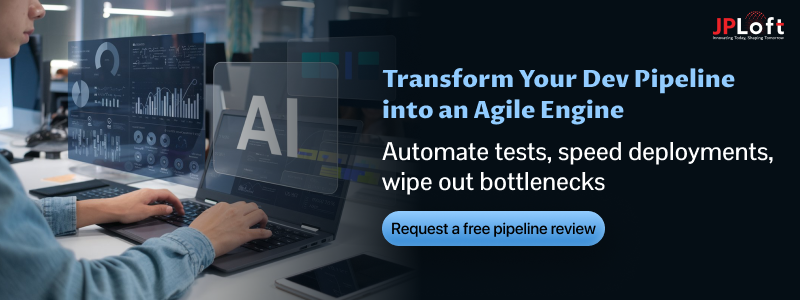Key Takeaways:
Agility models replace long marathons with quick sprints, so you ship a testable slice every few weeks and learn as you go.
Agility in technology runs on a build-measure-learn loop, letting your product evolve alongside users rather than trailing behind them.
Time-to-market matters because early releases capture data, cut costs, sidestep risks, and secure brand mindshare before rivals catch up.
Traditional waterfall can take up to a year, while an agile sprint cadence gets an MVP live in roughly ten weeks and a full release in four to six months.
Actionable tips such as data health checks, CI/CD model tests, feature flags, shared metrics, and debt hours maintain speed without sacrificing quality.
JPLoft brings sprint-zero roadmaps, reusable microservices, and weekly demos, turning agile theory into production-ready AI apps at record pace.
Ever feel like your AI project is aging while it’s still on the whiteboard? Swap the marathon for a series of sprints.
With Agility in AI development, you treat data pipelines like product features, build a slice, ship it, learn, repeat.
Each tiny release sharpens the model, keeps users engaged, and spares you the panic of a last-minute “big-bang” launch.
The result? Rapid AI deployment that actually lasts, giving you room to iterate while competitors are still debating specs.
Stick around, and we’ll break down how these Agility models accelerate AI solutions.
Quick Overview: Agility in Technology
Agility in technology is your organization’s capacity to pivot without panic and deliver value on a dime.
Think of it as a loop: ideate, build, release, learn- repeat.
If you’re asking how Agile practices accelerate AI solutions, you have to go through this blog.
Cross-functional squads push shippable increments instead of betting everything on a “big-bang” release.
Automated tests, CI/CD, and MLOps keep the feedback flowing so you can create an AI app once and refine it continuously.
The result? Faster insights, fewer surprises, and a product that evolves with your users, not behind them
One of the many benefits of Agility models in AI development is to reduce the time to market. But the question that you should be asking is why time to market is so important.
Let’s get into it in the next section:
Why “Time-to-Market” Matters for Developing AI Apps?
Ship late, and you’re training on yesterday’s data. Ship early, and every user interaction sharpens your model.
That’s the edge Agile methodologies give you. Let’s find out the benefits & more about how agility accelerates AI development:
1. Speed Turns Data into Leverage
Do you know 70 % of Agile-mature companies say, “it directly speeds time-to-market.”
When you release early, every click becomes fresh training data that refines your model.
Harnessing agility in technology to accelerate AI solutions helps you to keep that loop tight, plan a sprint, push an update, and learn fast.
The result is rapid AI deployment that leaves slower competitors training on yesterday’s reality instead of today’s signals.
2. Early Entry Locks in Mindshare
Users gravitate to the first app that actually works, then stick around as it improves.
By using agile methodology for AI, you shorten release cycles, hit the market first, and gather brand equity while others debate architecture.
That momentum is hard to steal once your product becomes the default choice.
3. Iterative Launches Cut Hidden Costs
Long, waterfall-style builds often bury scope creep and rework.
Agile practices accelerate AI solutions by keeping features modular, so you can cancel weak ideas before they drain the budget.
You not only reduce the AI product lifecycle but also protect cash flow by funding what proves valuable in real-world tests.
4. Smaller Increments Curb Technical Risk
Complex AI pipelines break in surprising ways.
Shipping in weekly or bi-weekly slices exposes bugs early, when fixes are cheap.
This is how you speed up AI development without sacrificing stability: each increment is small enough to debug yet meaningful enough to deliver user value.
5. Compliance Hurdles Shrink When Tackled Continuously
Regulations on privacy, bias, and security can stall a big-bang launch for months.
An agile methodology reduces AI solutions’ time to market by baking governance checks into every sprint.
Issues surface quickly, giving you time to correct course instead of scrambling during a last-minute audit.
6. Team Morale Soars with Visible Progress
Nothing motivates a cross-functional pod like seeing their work in customers’ hands within weeks.
Frequent wins reinforce a culture of experimentation, making AI with Agile methodology feel less like guesswork and more like a disciplined sport.
Happy teams iterate faster, driving a flywheel of innovation you can’t fake.
So, these are some common reasons to use Agile methodologies to reduce time to market your AI solution.
How Long Does it Take to Develop an AI App?
A traditional, phase-gated build can stretch 9–12 months.
Discovery drags on, hand-offs pile up, and by the time you go live, models may already feel stale.
The cost to develop an AI app in that scenario usually lands between $120K and $450K, depending on data complexity, cloud usage, and post-launch support.
Contrast that with a sprint-driven approach. Using Agile methodologies to reduce AI app development timeline, teams push an MVP with core models to beta in as little as 4–6 months, then refine features in two-week cycles.
The same scope often lands closer to $90K–$350K because rework and idle time drop sharply.
To better understand this whole fiasco, here is a comparison of normal tasks alongside how Agile practices accelerate AI solution.
|
Phase |
Waterfall Tasks & Duration |
Agile Sprint Tasks & Duration* |
|
Discovery & Requirements |
4–6 weeks: market analysis, fixed scope docs |
2 weeks: backlog creation, sprint-0 planning |
|
Data Collection & Preparation |
6–8 weeks: bulk ETL, single labelling push |
3 weeks: high-value data first; rolling labelling each sprint |
|
Model Prototyping |
8 weeks: single proof-of-concept cycle |
4 weeks: rapid experiments inside two-week sprints |
|
Full-Stack Development |
10 weeks: UI, APIs, integration, no interim releases |
6 weeks: incremental features shipped to staging every sprint |
|
System & User Testing |
6 weeks: QA only after full build |
Continuous: automated tests every commit; user feedback each sprint |
|
Deployment |
2 weeks: “big-bang” cut-over weekend |
1 week: blue-green or canary rollout via MLOps pipeline |
|
Post-Launch Iterations |
8 weeks: single patch cycle |
Ongoing: two-week sprints for enhancements and retraining |
|
Total to MVP |
6–8 months |
2-3 months |
|
Total to Feature-Complete Release |
9–12 months |
4–6 months |
Durations assume two-week sprints, CI/CD automation, and a cross-functional squad.
Using Agile methodologies to reduce AI app development timeline lets you see an MVP in users’ hands within 10 weeks instead of eight months.
The continuous-delivery rhythm- planning, coding, testing, and deploying in tight loops dramatically reduces AI development time with Agile methodologies and keeps every future improvement on the same fast track.
How Agility Models Cut AI Development Delivery Time: Key Points
Need to land your AI product months sooner? Agility models reduce AI delivery time by swapping slow, phase-gated plans for short, data-driven loops.
When you rely on agile methodologies, every sprint puts a testable slice in front of users, so learning starts early and rework stays low.
Below you’ll find eight expanded points with proper information, so you understand better and make better decisions:
1] Sprint-Sized Roadmaps Keep Scope Razor-Thin
Cut the backlog into two-week slices, then commit only to features that unlock the next experiment.
You dodge “nice to haves,” gold-plating, and endless change requests.
During sprint review, hidden risks pop up fast, letting teams pivot before minor issues balloon.
Because developing an AI app with Agile methodologies forces ruthless prioritisation, you often shave three to four weeks off the discovery phase alone while boosting confidence in every deliverable that makes the cut.
2] Continuous Data Curation Sharpens Models Fast
The first Role of Agile practices in AI development is treating datasets like living code.
Label just enough data to train a baseline, release it, then let real-world feedback guide the next labeling wave.
This tight loop prevents months of over-collection and keeps data scientists focused on the highest-impact features.
The payoff is faster convergence, reduced storage costs, and two to three weeks trimmed from the data-prep stage of every project.
3] Automated MLOps Erases Deployment Bottlenecks
CI/CD pipelines lint code, validate datasets, run bias tests, and package models the moment you push to Git.
That’s the first impact of Agility in technology, which once took a week for DevOps approval, now staging hours.
Engineers spend time tuning hyperparameters instead of writing deployment tickets, compressing each release cycle by seven to ten days and building a repeatable launch rhythm.
4] Cross-Functional Squads Kill Hand-off Delays
The second Role of Agile practices in AI development is cultural alignment.
Data scientists, back-end engineers, and product owners share a daily stand-up, so blockers,
“Does the ROC curve meet our launch bar?”, get cleared instantly.
Decision latency, the silent killer of timelines, drops to near zero.
Momentum flows uninterrupted from ideation to release, often reclaiming an extra five to seven days per sprint that would otherwise vanish in email threads.
5] Incremental Governance Prevents Launch-Day Scrambles
Bias scans, privacy checks, and security tests run inside each sprint, not after the code freeze.
The second Impact of Agile practices in Technology is risk mitigation: issues surface when fixes are cheap, not at the eleventh hour.
Regulators, legal teams, and auditors see a steady stream of evidence, clearing the runway for an on-time go-live and reclaiming two to three weeks usually lost to compliance firefighting.
6] Reusable Microservices Accelerate New Feature Tracks
A library of inference and data-pipeline microservices lets an AI agent development company clone proven components across projects.
Teams plug in a fresh intent classifier, tweak configs, and roll to production without rebuilding scaffolding.
That reuse multiplies velocity, slashes onboarding for new hires, and pulls ten to fourteen days out of every green-field feature timeline, especially when multiple squads are building in parallel.
7] Prototype-Driven UX Keeps Users Talking
Clickable mock-ups surface conversational snags before production code is written.
Our chatbot development services move from Figma to live demo in two sprints, using real user transcripts as training fodder.
Early feedback tightens the loop between design insight and model quality, trimming a full sprint from front-end polish and ensuring the experience feels intuitive from day one.
8] Rapid Market Tests De-Risk Expansion Plans
Feature flags expose new AI business ideas to 5 % of your audience, gather KPIs, and let you double down on winners while shelving duds.
This evidence-driven mindset keeps budgets aligned with value and frees leadership to green-light bold initiatives.
Because agility lets you fail fast and scale faster, you routinely claw back another two to three weeks otherwise burned on lengthy approval cycles, proof that agility models reduce AI delivery time in every phase.
See, there are various ways to reduce AI development time with the help of Agile models.
Challenges & Considerations While Utilizing Agile Methodologies
Rushing an MVP out the door is exciting, but the challenges in Agile models in reducing AI development time sneak in where you least expect them.
Data dependencies, compliance checkpoints, and model-drift alarms can all stall a sprint if you don’t prepare for them up front.
Think of agility as a turbo button: hit it without the right guardrails, and you may spin out instead of speeding ahead.
Challenge 1. Data Isn’t Always sprint-ready
Fresh data fuels every iteration, yet it often arrives late, dirty, or incomplete.
When backlogs hinge on missing datasets, even seasoned teams using Agile methodologies in AI development can stall.
Build buffer stories for data cleanup, automate validation scripts, and keep a “data health” dashboard so blocked work is visible before it hijacks velocity.
Challenge 2. Models Drift Faster Than Features
User behaviour, seasonality, and platform changes can nudge accuracy south in days.
The real Role of Agility methodologies in AI development shows up when you pair rapid releases with continuous monitoring, versioned datasets, and auto-retraining hooks.
Without that safety net, every sprint risks shipping an elegant but outdated model.
Challenge 3. Compliance Must Iterate, too
Privacy, bias, and security checks often live outside core sprints.
Wrap lightweight audits into the Definition-of-Done so legal teams review incrementally.
That way, Agile methodologies reduce AI development timeline without sacrificing governance, and you avoid last-minute “stop the launch” emails from risk officers.
Challenge 4. Cross-Functional Language Barriers
Data scientists debate precision-recall curves while product managers chase engagement KPIs. Daily stand-ups help, but shared metrics help more.
Translate model performance into business impact, think revenue lift or churn drop, so the AI development timeline is reduced by Agile methodologies without endless alignment meetings.
Challenge 5. Tooling Gaps Can Bottleneck Sprints
CI/CD for code is mature; CI/CD for models still trips teams up.
Invest early in MLOps: automated bias tests, canary deployments, and rollback scripts. When infrastructure keeps pace, Agile methodologies in AI development hit their stride and shipping becomes routine, not roulette.
Challenge 6. Innovation Budget vs. Tech Debt
Fast loops surface great ideas and hidden flaws.
Allocate a “debt day” each sprint to refactor brittle scripts, tune pipelines, and document edge cases.
Protecting this time ensures the Role of Agility methodologies in AI development isn’t just speed, but sustainable speed that scales with every new feature wave.
Tips to Move Forward With Agile Methodologies in AI Development
Speed is great, but direction is better.
Before you sprint, map your app development process into bite-sized loops, think two-week blocks where data, model tweaks, and UX polish travel together.
That rhythm is what allows teams to reduce the AI development timeline with Agile Methodologies without the usual pile-ups.
Below are six momentum-boosting moves that show how AI methodologies can reduce the AI development timeline while keeping your models sharp and your users happy.
1. Kick off Every Sprint with a Data Health Check
Dirty, late, or biased data is the silent killer of velocity. Run automatic validation scripts on day one, surface anomalies, and decide whether to fix or defer.
It’s the quickest way to reduce the AI development timelines with Agile models without tripping over surprise null columns two hours before demo day.
2. Automate Model Testing Inside Your CI/CD Pipeline
Unit tests catch syntax errors; model tests catch accuracy cliffs. Wire smoke tests, bias scans, and canary rollouts into every merge.
This tight feedback loop trims days per iteration and proves in real time how AI methodologies can reduce the AI development timeline without sacrificing quality.
3. Use Feature Flags for Experimental Models.
Release that new recommendation to 5 % of users, gather KPIs, then dial up or roll back instantly.
Feature flags keep innovation flowing while guarding the user experience, and they’re a practical lever to reduce the AI development timeline with Agile Methodologies because you learn from live data, not staging assumptions.
4. Run Cross-Functional Retros with Shared Metrics.
Precision-recall curves mean little to marketing; churn rate means little to data science.
Pick two or three metrics everyone cares about, say, conversion lift and latency and revisit them at every retro.
Shared language ends circular debates and ensures each sprint step actually moves the business forward.
5. Schedule a “Debt Hour” in Every Sprint.
Fast loops breed tech debt; ignore it and you’ll slow to a crawl. Set aside 60 minutes per cycle for refactors, doc clean-ups, and pipeline hardening.
This tiny investment keeps velocity sustainable and is one more way to quietly reduce the AI development time with Agile models over the long haul.
6. Keep a “Parking Lot” for Big Ideas.
Fresh insights pop up mid-sprint and can derail focus. Log them in a visible backlog column then forget them until planning.
This habit protects current commitments while ensuring the next sprint’s backlog is rich with validated ideas, reinforcing the flywheel of continuous improvement.
Adopt even three of these tactics and you’ll feel the calendar compress, proof that smart, intentional agility beats frantic hustle every time.
How JPLoft Can Help You Develop an AI App With Agile Models?
Ready to swap endless planning sessions for real traction? JPLoft is the AI App Development Company that turns ideas into shippable AI products fast.
Our cross-functional squads kick off with a sprint-zero roadmap, automate model testing through MLOps, and keep you in the loop with weekly demos.
Need a chatbot, recommender, or fraud-detection engine? We plug reusable microservices into your stack, trim weeks of boilerplate, and let feature flags gather live user data from day one.
The result: predictable iterations, early ROI, and a launch timeline that feels measured in weeks, not fiscal quarters.
Conclusion
Agility is the difference between chasing market shifts and setting them.
When you use Agile models to reduce AI development time, you trade bloated timelines for tight, repeatable loops of build-measure-learn.
Each sprint puts a working slice in front of users, turning feedback into fuel instead of rework. Automated MLOps pipelines catch drift before it derails accuracy, while cross-functional squads keep decision latency near zero.
The payoff is a product that ships months sooner, improves every fortnight, and scales on proven data, not hunches.
Pair that rhythm with JPLoft’s AI expertise, and you’ve got a launch plan built for winning.
FAQs
Most projects reach a functional MVP in 4–6 two-week sprints. Exact timing depends on data readiness, compliance scope, and feature complexity.
Yes. Lightweight bias scans, privacy checks, and security tests are baked into each sprint, so governance moves in lockstep with development.
A data scientist, ML engineer, backend/devops engineer, product owner, and UX lead form the core pod. Additional specialists join as tasks require.
Continuous data ingestion pipelines and versioned datasets keep the model reproducible. Drift alerts trigger immediate backlog items for retraining.
Feature flags limit exposure, while rapid retraining and A/B tests let you iterate without a full rollback—turning “failure” into fast feedback, not a schedule slip.













Share this blog